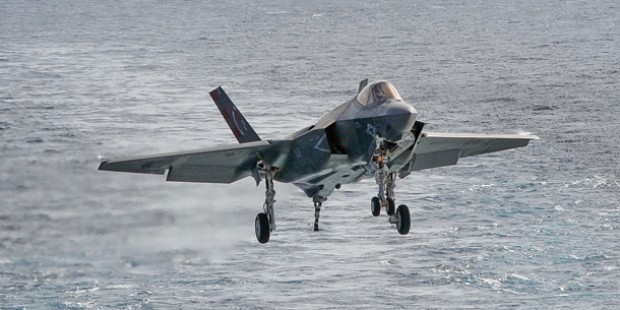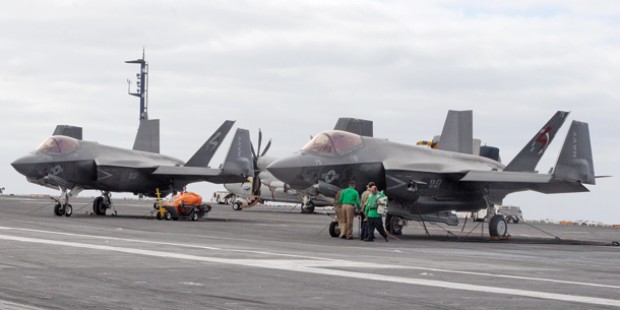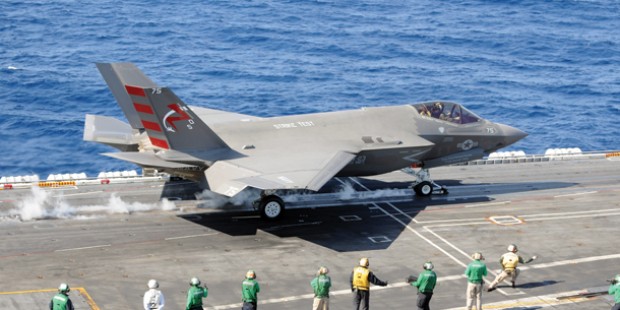It’s been almost 8 years since the first F-35 Lightning II (a.k.a. the Joint Strike Fighter) took flight, but after many delays and massive cost overruns, the F-35 has finally made it to the end of testing before it goes into full production by Lockheed Martin with help from other defense contractors Northrop Grumman, Pratt & Whitney, and BAE Systems.
Three different variants were designed for the U.S. Air Force (Model A), the U.S. Marine Corps (Model B) and the U.S. Navy (Model C). The differences between the three are fairly simple. The “A’ is your conventional take off and landing variant strictly a land-based fighter, the “B” has the short-take off and vertical-landing capabilities such as the AV-8 Harrier II, and the “C” is the carrier-based with re-enforced landing gear and a tail hook.
Each variant can carry the same weapons and load, but the “A” and “C” each have a non-combat range of 1200 nautical miles, where the “B” has only 900 nautical miles. The combat range is approx. 600 nautical miles, with the maximum speed reaching Mach 1.6.
The Marine Corps received its first three planes back in November 2012, after much testing and reaching several milestones throughout the year 2011. The U.K. was the first allied nation to receive an F-35 Lightning II aircraft in a ceremony July 12, 2012.
The first F-35C Lightning II Navy variant arrived at Strike Fighter Squadron 101 located at Eglin Air Force Base, Fla., on June 22, 2013. Continued testing finally brought us to where we were now on the USS Nimitz (CVN 68). On November 3, 2014, The Navy made aviation history, as an F-35C Lightning II conducted its first arrested landing aboard an aircraft carrier off the coast of San Diego. Navy test pilot Commander Tony Wilson landed the CF/05 or #75 F-35C test aircraft at 12:18 p.m. aboard the USS Nimitz. Testing would last for 14 days onboard the Nimitz.
“Today is a landmark event in the development of the F-35C,” said Wilson, a Navy test pilot with Air Test and Evaluation Squadron (VX- 23). “It is the culmination of many years of hard work by a talented team of thousands. I’m very excited to see America’s newest aircraft on the flight deck of her oldest aircraft carrier, the USS Nimitz.”
On November 13th, The Military Press was invited to fly out to the USS Nimitz to observe the continue testing of the two F-35C’s that were onboard.
While there seemed to be plenty of wind this day, it apparently was not going to be fast enough for the testing that was to be done. Captain John Ring Commanding Officer of the Nimitz, made the comment, “Well, if Mother Nature doesn’t cooperate, we’ll make our own wind,” as the Nimitz would be pushed to her maximum speed to help with the wind and the launches.
Read the Military Press interview with Navy test pilot Cmdr. Tony Wilson at www.militarypress.com/f-35ctesting.com.
Cmdr. Wilson took time to discussed the testing of the F-35C and the take off’s and landings (traps). Cmdr. Wilson who has flown F/A-18 C’s& F’s recorded his 500th trap during this current round of testing, and made his 500th with the F-35C.
MP: What have you learned so far in this series of tests, any issues?
Wilson: “We are conducting developmental test and we are learning, and the results thus far have been promising. The issues we’ve had, have been very minor and expected. We expected to have some problems, but to our surprise, everything has been going well. What we have learned is that the plane is integrating very well with the sensor usage, our network capabilities, as well as our maintenance and sustainability.”
MP: What was the main difference between the F/A18 and the F-35 when making your traps?
Wilson: “The handling qualities are nice, and the landing difference between the F/A-18 and the F-35C, is with the Control Laws software. The plane is very well behaved and the trap itself with the F-35C seems softer when landing.”
MP: What are the Control Laws?
Wilson: “The Control Laws, is revolutionary software that is in our flight control computers, and is designed to help the pilot land, making minute adjustments as the plane approaches the deck, making landing almost an administrative task, thus making the approaches and landings easier for the pilot. it will increase our safety margins out here.” So when you hear, “fly by wire” this is what were talking about. It’s basically the software in the computers that helps us fly the jet.”
MP: How is the new helmet working? (The F-35 Gen III Helmet Mounted Display System (HMDS) built by Rockwell Collins ESA Vision Systems International combines infrared, night-vision, augmented and virtual reality to let pilots see more than ever before — including right down through the plane itself).
Wilson: The helmet performance has been going very well. We have not seen any issues with the helmet thus far and it is performing as advertised. We currently are still using the Gen II helmet.
This series of testing has been done “Clean Wings”, with no ordinance stored under the aircrafts wings, but that phase is schedule for sometime in 2015. The F-35C is not expected to reach the actual fleet until 2018.
Standing high above the flight deck, we were positioned along Vulture’s Row (an observation area on the “Island” of the Carrier). Commander Tony Wilson, was in the cockpit and readying the aircraft for launch. The Nimitz turned into the wind and was going at 30+ knots.
Cmdr. Wilson and the F-35C roared to life and took off with only a slight dip, once off of the flight deck. He climbed in elevation and did several looping passes with gear down around the Nimitz, before coming in for a landing about 10 minutes later. After refueling, Cmdr. repeated his last flight and it was time for us to leave the Nimitz and reboard our C-2A Greyhound and fly back to NASNI.
After leaving the Nimitz, the first night time launch and recovery of the F-35C was conducted and it was successful.
We would like to thank the United States Navy’s 3rd Fleet, Rear Admiral Dee Mewbourne, Commander, Carrier Strike Group 11, Captain John Ring, Commanding Officer of the USS Nimitz, Lt. Commander Clint Phillips, the USS Nimitz Public Affairs Officer and his staff, Commander Jeannie Groeneveld, the Naval Air Forces Public Affairs Officer and her staff, Commander Tony Wilson, test pilot for VX-23, and lastly Jim Gigliotti, Director, F-35C, and Navy Program Manager, and the rest of the fine people from Lockheed Martin, for this wonderful opportunity of observing Naval history in the making.



